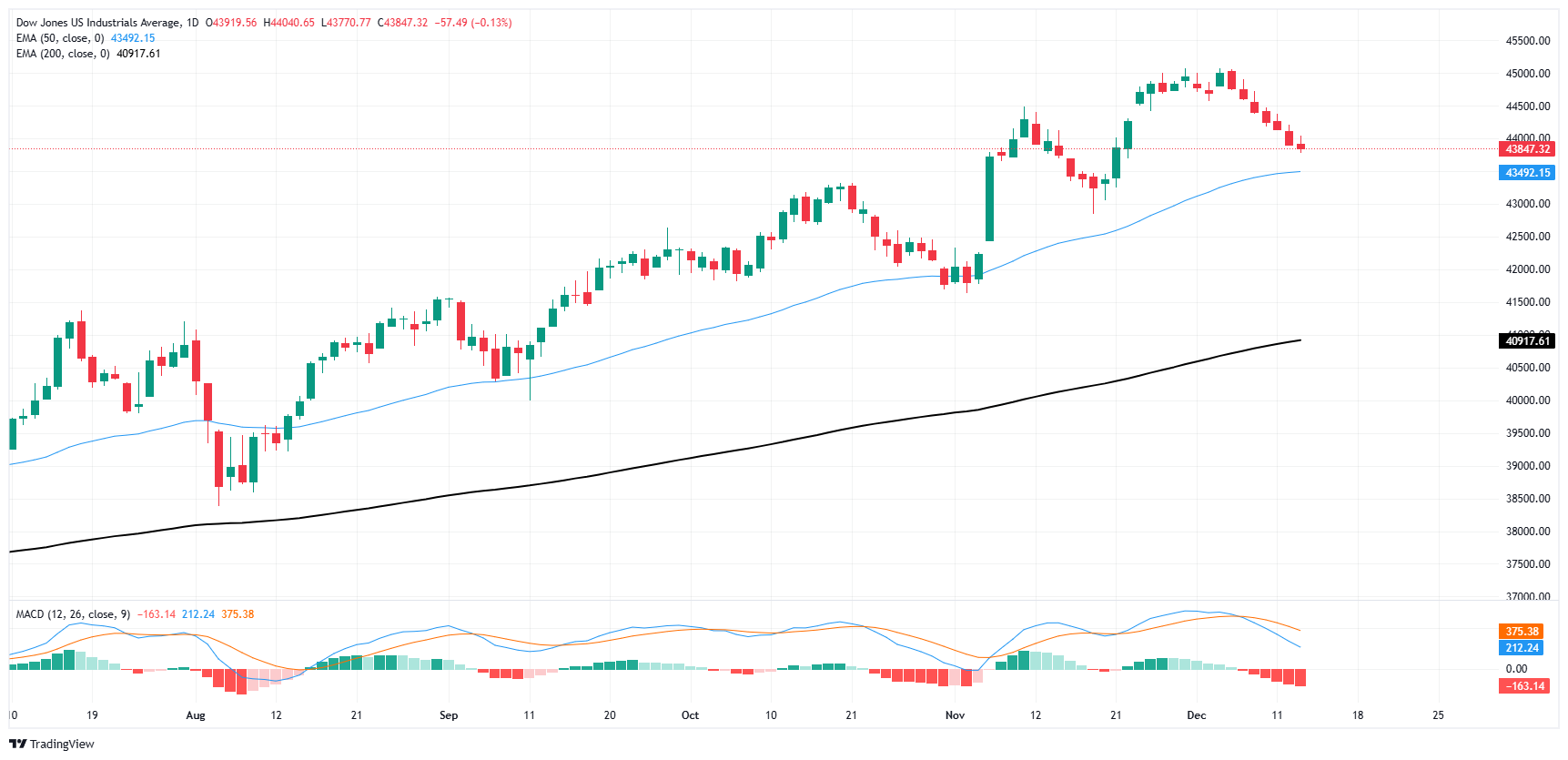- The Dow Jones falls another 0.25% during a quiet Friday session.
- Stock indexes are mostly lower as investors weigh their options.
- Markets are already looking ahead to next week’s Fed rate decision on December 18.
The Dow Jones Industrial Average (DJIA) weakened during a quiet session on Friday. The economic calendar was strictly dovish during the US market session, leaving investors mulling over the future pace of Federal Reserve (Fed) rate cuts. The DJIA extended a thin but persistent short-term decline, falling further below the 44,000 zone and recording a seventh consecutive day of lower trading.
U.S. Export-Import Price Index figures released on Friday far exceeded expectations, but the low-impact data barely registered in the market as investors look ahead to the U.S.’s high-impact economic calendar. next week. A new round of US Purchasing Managers’ Index (PMI) surveys will begin next week, with S&P Global Manufacturing and Services PMI figures due out on Monday. US retail sales figures for November will follow on Tuesday and are expected to rise to 0.5% from 0.4% monthly.
US inflation indicators accelerated in November, according to this week’s key data releases. However, the rise in costs was not enough to sway investors from their current bets on a quarter-point cut in the Fed’s rate decision scheduled for next week on Wednesday, December 18. According to CME’s FedWatch tool, rate traders have confidently bet the Fed will cut one last time in 2024 with a 97% chance of a 25 basis point rate cut next week.
Dow Jones News
Most of the Dow Jones is trading calmly, but losses in key stocks are dragging the overall board lower, with Nvidia (NVDA) losing about 2.5% and falling to $134 per share as the Dow’s tech rally general market takes a pause. On the positive side, UnitedHealth Group (UNH) has recovered 1.2% on Friday, rising back above $522 per share after several days of headline-driven losses.
Dow Jones Price Forecast
Friday’s more than 100-point drop in the Dow Jones puts the main stock board nearly 3% below recent all-time highs above 45,000. Despite seven consecutive days of lower trading, the Dow Jones still remains comfortably in bullish territory with price action north of the 50-day Exponential Moving Average (EMA) near 43,490.
A short-term bearish drag on index prices may be quickly running out. The Dow Jones has shown a stellar track record over the past 12 months of outperforming its own moving averages. Buyers will likely look to re-enter the fray once bids make contact with the 50-day EMA. However, a quick drop below the latest low towards the 43,000 area could see a new round of bearish momentum.
Dow Jones Daily Chart
The Dow Jones FAQs
The Dow Jones Industrial Average, one of the world’s oldest stock indices, is made up of the 30 most traded securities in the United States. The index is weighted by price rather than capitalization. It is calculated by adding the prices of the securities that comprise it and dividing them by a factor, currently 0.152. The index was founded by Charles Dow, also founder of the Wall Street Journal. In recent years it has been criticized for not being sufficiently representative, since it only follows 30 companies, unlike broader indices such as the S& P 500.
There are many factors that drive the Dow Jones Industrial Average (DJIA). The main one is the aggregate performance of its component companies, revealed in quarterly corporate earnings reports. US and global macroeconomic data also contribute, influencing investor sentiment. The level of interest rates, set by the Federal Reserve (Fed), also influences the DJIA, as it affects the cost of credit, on which many companies largely depend. Therefore, inflation can be a determining factor, as well as other parameters that influence the decisions of the Federal Reserve.
The Dow Theory is a method for identifying the main trend of the stock market developed by Charles Dow. A key step is to compare the direction of the Dow Jones Industrial Average (DJIA) and the Dow Jones Transportation Average (DJTA) and only follow trends where they are both moving in the same direction. Volume is a confirmation criterion. The theory uses elements of maximum and minimum analysis. The Dow theory proposes three phases of the trend: accumulation, when the smart money begins to buy or sell; public participation, when the general public joins the trend; and distribution, when the smart money abandons the trend.
There are several ways to trade the DJIA. One of them is to use ETFs that allow investors to trade the DJIA as a single security, instead of having to buy shares of the 30 companies that comprise it. A prominent example is the SPDR Dow Jones Industrial Average ETF (DIA). Futures contracts on the DJIA allow traders to speculate on the future value of the index, and options provide the right, but not the obligation, to buy or sell the index at a predetermined price in the future. Mutual funds allow investors to purchase a portion of a diversified portfolio of DJIA securities, providing exposure to the global index.
Source: Fx Street
I am Joshua Winder, a senior-level journalist and editor at World Stock Market. I specialize in covering news related to the stock market and economic trends. With more than 8 years of experience in this field, I have become an expert in financial reporting.







